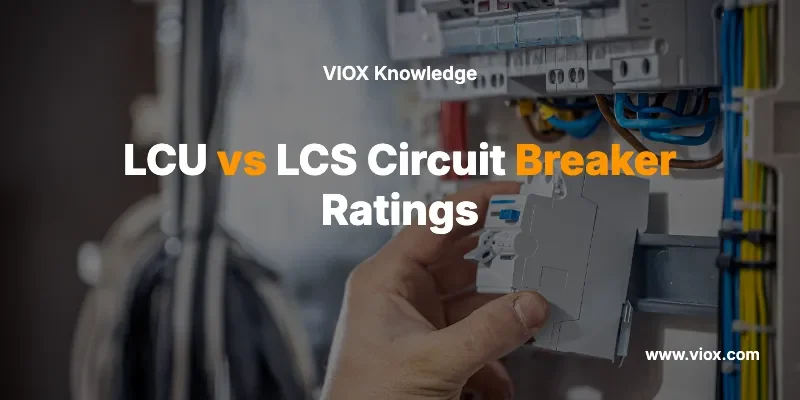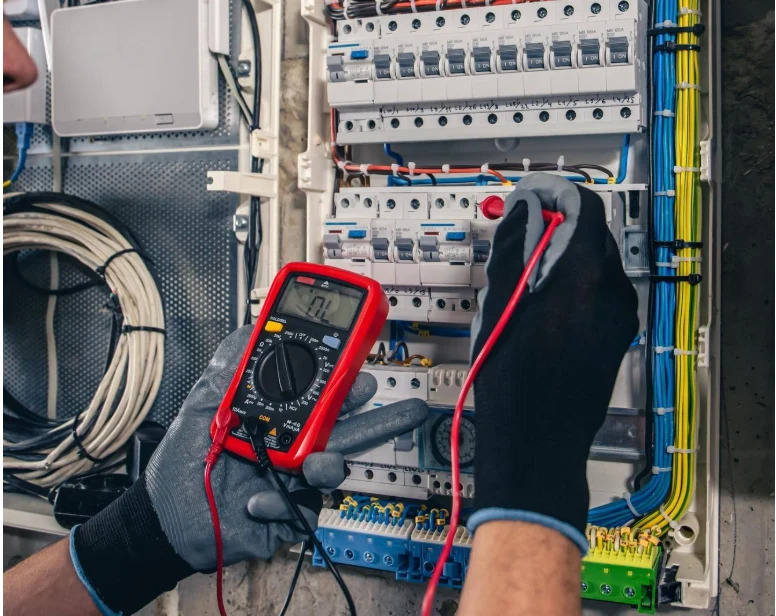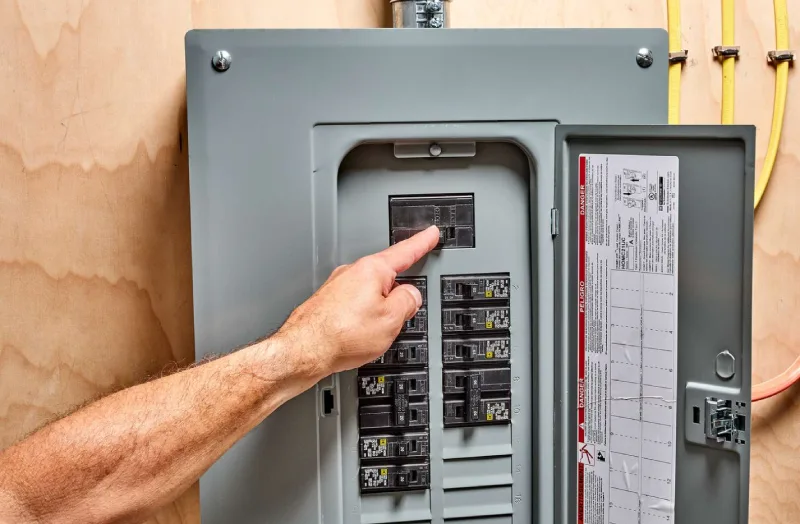Direct Answer: LCU (Limiting Current Under short circuit) and LCS (Limiting Current under Service conditions) are two critical circuit breaker ratings that define maximum current interruption capabilities. LCU measures the highest short-circuit current a breaker can safely interrupt under fault conditions, while LCS indicates the maximum current during normal service operations. Understanding these ratings is essential for proper circuit breaker selection and electrical system safety.

What Are LCU and LCS Circuit Breaker Ratings?
LCU (Limiting Current Under short circuit conditions) represents the maximum prospective short-circuit current that a circuit breaker can interrupt safely. This rating ensures the breaker can handle the most severe fault conditions without catastrophic failure.
LCS (Limiting Current under Service conditions) defines the maximum current the circuit breaker can handle during normal operational use, including planned load switching and minor overload conditions.
Key Differences Between LCU and LCS Ratings
Here is a table that shows the fundamental differences between LCU and LCS circuit breaker ratings:
| Characteristic | LCU (Limiting Current Under short circuit) | LCS (Limiting Current under Service) |
|---|---|---|
| Primary Purpose | Short-circuit fault protection | Normal operational current handling |
| Current Type | Maximum fault current interruption | Maximum service current interruption |
| Frequency of Use | Emergency fault conditions only | Regular operational switching |
| Testing Standard | IEC 60947-2, UL 489 | IEC 60947-2, UL 489 |
| Typical Values | 10kA to 200kA+ | 1kA to 100kA |
| Safety Factor | Critical for system protection | Important for operational reliability |
| Cost Impact | Higher LCU = higher cost | Higher LCS = moderate cost increase |
Technical Specifications and Standards Compliance
LCU Rating Classifications
⚠️ Safety Warning: Always verify LCU ratings exceed calculated fault currents by at least 25% safety margin per NEC 110.9.
Circuit breakers are classified by LCU ratings according to these industry standards:
- Low LCU (5-15kA): Residential and light commercial applications
- Medium LCU (25-65kA): Commercial and light industrial systems
- High LCU (100kA+): Heavy industrial and utility applications
LCS Rating Categories
LCS ratings typically follow these classifications:
- Standard LCS (25-50kA): General commercial use
- Enhanced LCS (65-100kA): Industrial applications with frequent switching
- Premium LCS (100kA+): Critical infrastructure and heavy industry
Real-World Applications and Use Cases
When LCU Rating Is Critical
- Power Distribution Systems: In electrical panels serving large commercial buildings, LCU ratings of 65kA or higher ensure protection against utility-level fault currents.
- Industrial Motor Control Centers: Manufacturing facilities require circuit breakers with LCU ratings matching or exceeding calculated short-circuit currents at the point of installation.
- Emergency Generator Systems: Backup power systems need appropriate LCU ratings to handle generator fault contributions safely.
When LCS Rating Matters Most
- Frequent Load Switching: Operations requiring regular motor starting, lighting control, or equipment cycling benefit from higher LCS ratings.
- Variable Load Applications: Systems with changing power demands, such as data centers or manufacturing lines, require adequate LCS capacity.
- Maintenance Operations: Facilities requiring regular electrical maintenance need circuit breakers with sufficient LCS ratings for safe isolation procedures.
How to Choose Between Different LCU and LCS Ratings
Expert Tip: Calculate Required Ratings First
Before selecting circuit breakers, perform these essential calculations:
- Short-Circuit Analysis: Calculate maximum available fault current at each breaker location
- Load Analysis: Determine maximum operational currents including starting currents
- Safety Factor Application: Add 25% minimum safety margin to calculated values
Selection Criteria Framework
Step 1: Determine Required LCU Rating
- Calculate short-circuit current at installation point
- Include utility contribution and local generation
- Add safety factor per NEC 110.9 requirements
- Select breaker with LCU ≥ calculated fault current
Step 2: Evaluate LCS Requirements
- Assess normal operational current levels
- Consider motor starting currents and inrush
- Account for future load growth (typically 25%)
- Select appropriate LCS rating for application
Step 3: Verify Code Compliance
- Confirm ratings meet NEC, IEC, or local code requirements
- Check coordination with upstream protective devices
- Validate with electrical engineer or certified professional
Common Selection Mistakes and Troubleshooting
Safety Warning: Improper Rating Selection Risks
Installing circuit breakers with inadequate LCU or LCS ratings can result in:
- Equipment damage during fault conditions
- Fire hazards from arc flash incidents
- Electrical system instability
- Code violations and inspection failures
Troubleshooting Rating Issues
Problem: Circuit breaker trips frequently during normal operation
Solution: Check if LCS rating is adequate for actual load conditions, including starting currents
Problem: Breaker fails to interrupt fault current properly
Solution: Verify LCU rating exceeds calculated short-circuit current at installation point
Problem: Coordination issues with upstream devices
Solution: Ensure proper selectivity between LCU/LCS ratings throughout the electrical system
Professional Installation and Safety Requirements
Code Compliance Requirements
National Electrical Code (NEC) 110.9: Circuit breakers must have interrupting ratings sufficient for the available fault current.
IEC 60947-2 Standard: International standard defining test procedures and performance requirements for LCU and LCS ratings.
UL 489 Certification: Underwriters Laboratories standard ensuring circuit breaker performance meets safety requirements.
Expert Tip: Professional Verification Required
Always have qualified electrical engineers verify:
- Short-circuit calculations and studies
- Circuit breaker coordination analysis
- Code compliance and inspection readiness
- Safety factor adequacy for specific applications
Quick Reference: LCU vs LCS Selection Guide
For Residential Applications
- LCU Rating: 10-15kA typically sufficient
- LCS Rating: Based on panel amperage and load requirements
- Key Consideration: Utility fault current availability
For Commercial Buildings
- LCU Rating: 25-65kA depending on service size
- LCS Rating: Match operational switching requirements
- Key Consideration: Future expansion and load growth
For Industrial Facilities
- LCU Rating: 65kA+ for motor control centers
- LCS Rating: Enhanced ratings for frequent switching
- Key Consideration: Motor starting and arc flash analysis
Frequently Asked Questions
What happens if I use a circuit breaker with insufficient LCU rating?
Using a breaker with inadequate LCU rating creates serious safety hazards. During fault conditions, the breaker may fail to interrupt the current properly, leading to equipment damage, fire, or arc flash incidents.
How do I calculate the required LCU rating for my application?
Perform a short-circuit study to determine maximum available fault current at each breaker location. This requires calculating utility contribution, transformer impedance, and conductor impedance to the point of installation.
Can I use a circuit breaker with higher LCU or LCS ratings than required?
Yes, using breakers with higher ratings than minimum requirements provides additional safety margin. However, this typically increases cost, so balance safety requirements with budget considerations.
What is the difference between LCU and breaking capacity?
LCU (Limiting Current Under short circuit) and breaking capacity both relate to fault current interruption, but LCU specifically refers to the maximum current under short-circuit conditions, while breaking capacity may include other operational parameters.
Do LCU and LCS ratings affect circuit breaker coordination?
Yes, proper coordination requires matching LCU and LCS ratings throughout the electrical system to ensure selective operation during fault and overload conditions.
How often should LCU and LCS ratings be verified?
Verify ratings during initial installation, system modifications, load additions, or utility service changes. Periodic review every 5 years ensures continued adequacy as systems evolve.
What safety certifications should I look for in circuit breaker ratings?
Look for UL 489 listing, IEC 60947-2 compliance, and CSA certification. These ensure the stated LCU and LCS ratings have been independently verified through proper testing procedures.
Are there special considerations for LCU and LCS in renewable energy systems?
Yes, solar and wind systems can contribute to fault currents, affecting required LCU ratings. Additionally, inverter-based systems may require special consideration for LCS ratings due to switching characteristics.
Conclusion and Expert Recommendations
Understanding LCU and LCS circuit breaker ratings is fundamental to electrical system safety and reliability. LCU ratings protect against catastrophic fault conditions, while LCS ratings ensure proper operation during normal service.
Key takeaways for proper selection:
- Always calculate actual system requirements before selecting ratings
- Apply appropriate safety factors per applicable electrical codes
- Consider future load growth and system modifications
- Verify compliance with NEC, IEC, and local code requirements
- Engage qualified electrical professionals for complex applications
⚠️ Final Safety Reminder: Circuit breaker selection significantly impacts electrical system safety. When in doubt, consult with licensed electrical engineers or certified electricians to ensure proper rating selection and code compliance.
Related
What Is a Miniature Circuit Breaker (MCB): Complete Guide for Safety and Selection
IEC 60898-1 vs IEC 60947-2: Complete Guide to Electrical Circuit Breaker Standards
Why Circuit Breakers DON’T Protect People: The Critical Safety Truth Every Homeowner Must Know





